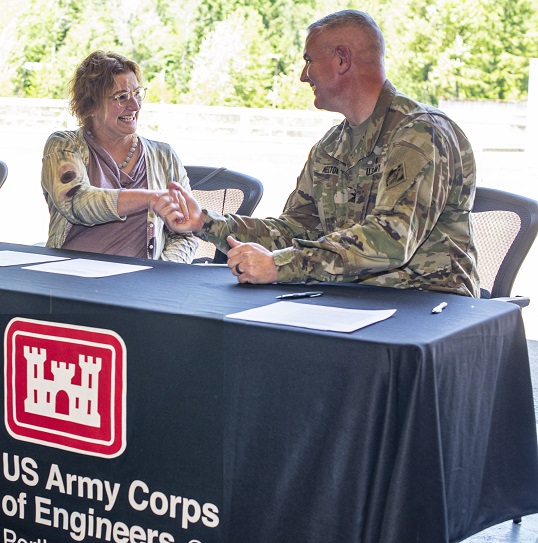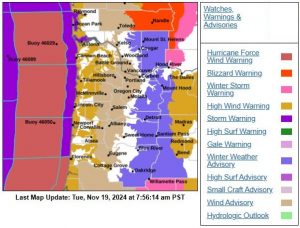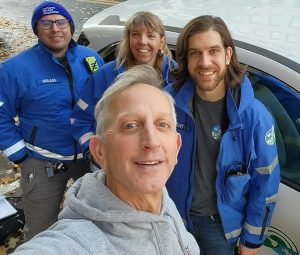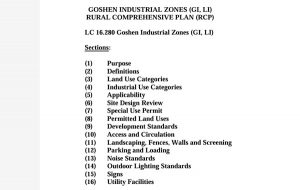Agreement seeks to preserve cultural resources while managing 13 dams and reservoirs
3 min read
Portland District, U.S. Army Corps of Engineers Commander Col. Mike Helton (far right) and Deputy State Historic Preservation Officer Chrissy Curran (middle) shake hands after signing a programmatic agreement May 31 at the Corps’ Foster Dam. The 10-year document, which the Corps developed through groundbreaking consultation with tribal nations, partner agencies, and local heritage-focused organizations, will enhance the protection of historic and cultural resources across the Willamette Valley while carrying out critical Corps projects. (U.S. Army Corps of Engineers photo)
PORTLAND, Ore. – Cultural resource specialists with the Portland District, U.S. Army Corps of Engineers (Corps) and partners have finalized an agreement that will enhance the protection of historic and cultural resources across the Willamette Valley, where the Corps manages 13 dams and reservoirs in addition to thousands of acres of land, while carrying out critical Corps projects.
Section 106 of the National Historic Preservation Act of 1966 (NHPA) requires federal agencies to consider any potential impacts their projects may have on historic properties. The new 10-year document, referred to as a programmatic agreement, goes a step further by creating efficiency for the Corps, stakeholders, and partner agencies as the Corps works to minimize its effects on the region’s shared, public heritage resources.
“Through this agreement, our actions and decisions will align more deliberately and consistently with the expectations of the nation, tribes, states, and partners,” said Erik Petersen, the Corps’ Willamette Valley operations project manager. “The result will be better, more efficient protection and stewardship of important cultural and historic values and resources.”
The document standardizes and streamlines the Corps’ approach to accounting for potential impacts to cultural and historic resources—for example, by establishing agreement on low-risk projects that don’t warrant additional consultation with partner agencies, allowing the Corps to focus its time and energy instead on more complex projects likely to have a greater effect on the area’s resources.
The agreement defines roles, responsibilities, and communication protocols to ensure the Corps is using its funding and personnel wisely for the preservation of cultural resources. It also continues engagement with consulting parties to make sure cultural resources are considered early on in project planning.
To develop the agreement, the Corps collaborated with the Oregon State Historic Preservation Office; Advisory Council on Historic Preservation; tribal nations; federal, state and local agencies; and local heritage-focused organizations with an interest in the Corps’ Willamette Valley Project.
“It’s not every day that local governments, local organizations, state and federal agencies, sovereign tribal governments, and the Advisory Council on Historic Preservation engage together in the 106 process in the way that the legislation intended,” said Deputy State Historic Preservation Officer Chrissy Curran, who also signed the Corps agreement. “It’s not lost on me that successful collaboration, negotiation, and meaningful consultation represent something far bigger in our world today than a project agreement.”
The Corps estimates that around 1,000 cultural and historical resources are located within its area of operations in the Willamette Valley. They include archaeological sites, historic buildings, landscapes with cultural or religious significance, and even the Corps’ own infrastructure—the protection of which helps to preserve the region’s history and heritage for future generations.
About the Willamette Valley System: The Corps’ Portland District operates 13 dams across the Willamette River Basin, from Detroit to Cottage Grove. Each dam contributes to a water resource management system that provides flood risk management, power generation, water quality improvement, irrigation, fish and wildlife habitat, and recreation for the Willamette River and many of its tributaries. Learn more: www.nwp.usace.army.mil/Locations/Willamette-Valley/






